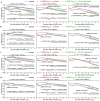Impairment of the Retinal Endothelial Cell Barrier Induced by Long-Term Treatment with VEGF-A165 No Longer Depends on the Growth Factor's Presence
- PMID: 35625661
- PMCID: PMC9138398
- DOI: 10.3390/biom12050734
Impairment of the Retinal Endothelial Cell Barrier Induced by Long-Term Treatment with VEGF-A165 No Longer Depends on the Growth Factor's Presence
Abstract
As responses of immortalized endothelial cells of the bovine retina (iBREC) to VEGF-A165 depend on exposure time to the growth factor, we investigated changes evident after long-term treatment for nine days. The cell index of iBREC cultivated on gold electrodes-determined as a measure of permeability-was persistently reduced by exposure to the growth factor. Late after addition of VEGF-A165 protein levels of claudin-1 and CD49e were significantly lower, those of CD29 significantly higher, and the plasmalemma vesicle associated protein was no longer detected. Nuclear levels of β-catenin were only elevated on day two. Extracellular levels of VEGF-A-measured by ELISA-were very low. Similar to the binding of the growth factor by brolucizumab, inhibition of VEGFR2 by tyrosine kinase inhibitors tivozanib or nintedanib led to complete, although transient, recovery of the low cell index when added early, though was inefficient when added three or six days later. Additional inhibition of other receptor tyrosine kinases by nintedanib was similarly unsuccessful, but additional blocking of c-kit by tivozanib led to sustained recovery of the low cell index, an effect observed only when the inhibitor was added early. From these data, we conclude that several days after the addition of VEGF-A165 to iBREC, barrier dysfunction is mainly sustained by increased paracellular flow and impaired adhesion. Even more important, these changes are most likely no longer VEGF-A-controlled.
Keywords: VEGF-A; cell adhesion; claudin-1; nintedanib; paracellular flow; plasmalemma vesicle associated protein; retinal endothelial cells; tight junction; tivozanib; transcellular flow.
Conflict of interest statement
H.L.D. has no conflicts of interest to declare. M.R. is consultant for Allergan, Alimera, Bayer and Novartis, received speaker honoraria from Allergan, Alimera, Bayer, Novartis, and Zeiss. A.W. received financial support from Alimera and Bayer and speaker honoraria from Alimera, Allergan, Bayer, Novartis, and Oertli.
Figures




References
-
- Aiello L.P., Avery R.L., Arrigg P.G., Keyt B.A., Jampel H.D., Shah S.T., Pasquale L.R., Thieme H., Iwamoto M.A., Park J.E., et al. Vascular endothelial growth factor in ocular fluid of patients with diabetic retinopathy and other retinal disorders. N. Engl. J. Med. 1994;331:1480–1487. doi: 10.1056/NEJM199412013312203. - DOI - PubMed
-
- Uemura A., Fruttiger M., D’Amore P.A., De Falco S., Joussen A.M., Sennlaub F., Brunck L.R., Johnson K.T., Lambrou G.N., Rittenhouse K.D., et al. VEGFR1 signaling in retinal angiogenesis and microinflammation. Prog. Retin. Eye Res. 2021;84:100954. doi: 10.1016/j.preteyeres.2021.100954. - DOI - PMC - PubMed
MeSH terms
Substances
LinkOut - more resources
Full Text Sources
Research Materials

